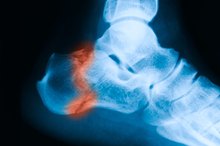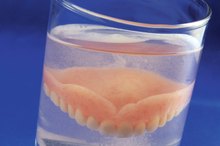Air Cast Vs. Plaster
Broken bones are part of many peoples’ lives, but medicine is finding new and improved ways of healing bones more effectively, and with less inconvenience to the patients. One method doctors have come up with is the air cast. An air cast serves the same purpose as a plaster or fiberglass cast, but with added benefits that make it a very popular alternative.
If you are experiencing serious medical symptoms, seek emergency treatment immediately.
Air Cast
An air cast consists of two durable plastic shells, each with an air pocket inside . The air pockets go on either side of the injured limb, with support straps to hold the cast in place. The air pockets can be inflated using tubing, or by simply blowing them up with your mouth. Air casts help with the same types of injuries as solid plaster or fiberglass casts do.
- An air cast consists of two durable plastic shells, each with an air pocket inside .
- The air pockets go on either side of the injured limb, with support straps to hold the cast in place.
Plaster Cast
What Are the Different Types of Splints?
Learn More
Plaster was once a popular casting material, but it has been taken over by fiberglass because that is thought to be a better material. A plaster cast is made from plaster of paris and gauze, setting the bone in place while the material is wet, and holding it in place once it dries and hardens. A plaster cast immobilizes the injured bone during the healing process, which typically takes around six weeks.
Uses
Both air casts and plaster casts are used for treating broken bones. They are designed to immobilize the break, keeping it set in place so it can heal properly.
Plaster casts are used only for broken bones, but air casts have a wider variety of uses 1. Air casts can be used for breaks, strains, and post-surgical protection, which has made them very popular in doctor’s offices and hospitals.
- Both air casts and plaster casts are used for treating broken bones.
- Air casts can be used for breaks, strains, and post-surgical protection, which has made them very popular in doctor’s offices and hospitals.
Benefits
The Duration of a Broken Finger
Learn More
Both plaster casts and air casts have benefits. Plaster casts are put on the injury permanently, allowing the bone to heal properly without interruption. The finished cast is extremely hard, and difficult to break unless struck with a great deal of force.
Air casts are removable, and they allow the patient to shower and swim. Air casts can be inflated to a level of comfort or necessity.
- Both plaster casts and air casts have benefits.
- Plaster casts are put on the injury permanently, allowing the bone to heal properly without interruption.
Disadvantages
The major disadvantage to a plaster cast is the inability to be around moisture. If a plaster cast gets wet, it can become soft or begin to mold inside. Plaster casts can also break if they are hit or fallen upon. Because there's no air circulation under a plaster cast, the patient can get sores and skin problems while she has it on.
The main problem with air casts is that because they are removable, patients risk reapplying them improperly, which might keep the bone from healing properly.
- The major disadvantage to a plaster cast is the inability to be around moisture.
- If a plaster cast gets wet, it can become soft or begin to mold inside.
Related Articles
References
- University of Minnesota Amplatz Children’s Hospital : Broken Bones
- Cleveland Clinic. Casts and splints. Updated April 16, 2017.
- American Academy of Ortopaedic Surgeons. Care of casts and splints. Updated August, 2015.
- American Academy of Orthopaedic Surgeons. Compartment syndrome. Updated October, 2009.
Writer Bio
Charissa Mennell has been a professional writer/editor since 2006, with a background in psychology, medicine and law. She has edited several books, including Cover Girls and Kindred, published by Blade Publishing.








